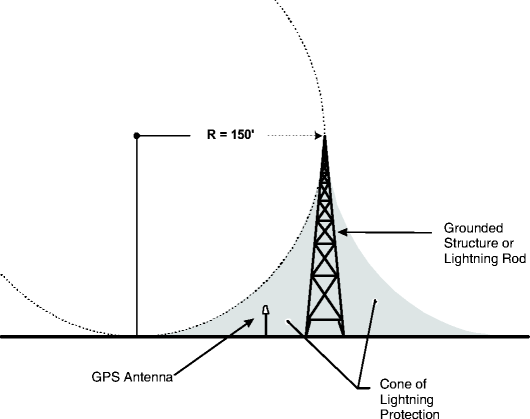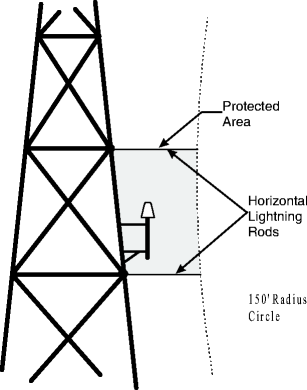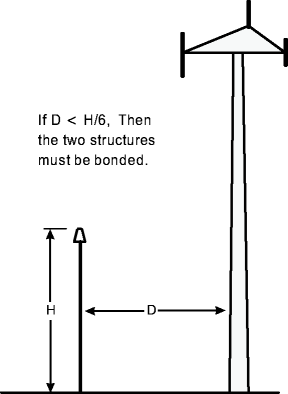| Lightning interference consideration | |||
|
| GO | ||
Industry standard practices for lightning protection should be followed for GPS antenna installations. Several sources for such information are:
Lucent Technologies Cell Site Grounding and Lightning Protection Guidelines (401-200-115)
National Fire Protection Agency (NFPA), NFPA 780, “Standard for Installation of Lightning Protection Systems”
Poly Phaser Corporation “The 'Grounds' for Lightning and EMP Protection” Second Edition by Roger R. Block.
The GPS antenna should be installed such that it is not the highest point in an installation (The GPS antenna must not be a lightning rod!). The GPS antenna must be within the “protective cone” (see Figure on the following page) of any grounded structure such as an antenna tower or ancillary lightning rod. The “protective cone” is the area between the circumference of a circle with a 150-foot radius that tangentially touches the ground and the side or top of a grounded structure and the ground or structure.
The following diagram shows the GPS antenna installed within the protective cone.

Important! The percentage of protection for the shaded zone is 96%.
If the GPS antenna is mounted to the side of an antenna tower above the 150-foot point, then horizontal lightning rods must be employed such that the antenna is within the area of a 150-foot sphere that touches both lightning rods, as shown in the following diagram.

In addition, the antenna cable shield must be grounded near the equipment.
If the GPS antenna is installed on a cell site antenna tower, the cable shield must be grounded and bonded to the tower, both at the top as close as possible to the antenna, and at the bottom at the tower footing as well as at the hatch plate.
Important! If the vertical cable run along the tower is more than 46 meters (150 feet), then multiple grounding bonds must be bonded at 30 meters (100 feet) intervals.
If the GPS antenna is mounted on a separate pole or structure of height (H) near an antenna tower or other grounded structure, and the distance (D) from the pole or structure to the tower or other grounded structure is less than the height of the pole divided by six (H/6), then the pole or structure and the antenna tower must be bonded together eliminate possible arc over during a lightning strike.
If the pole is 50 feet tall, then D=8.3 feet. (50/6 = 8.3).
Refer to the following diagram for more detail.

|
|
GO | ||
| © Alcatel-Lucent | |||